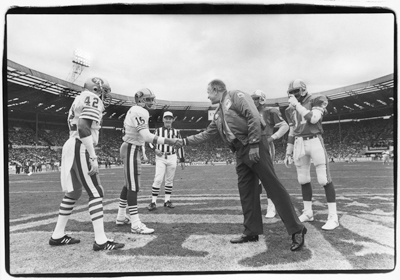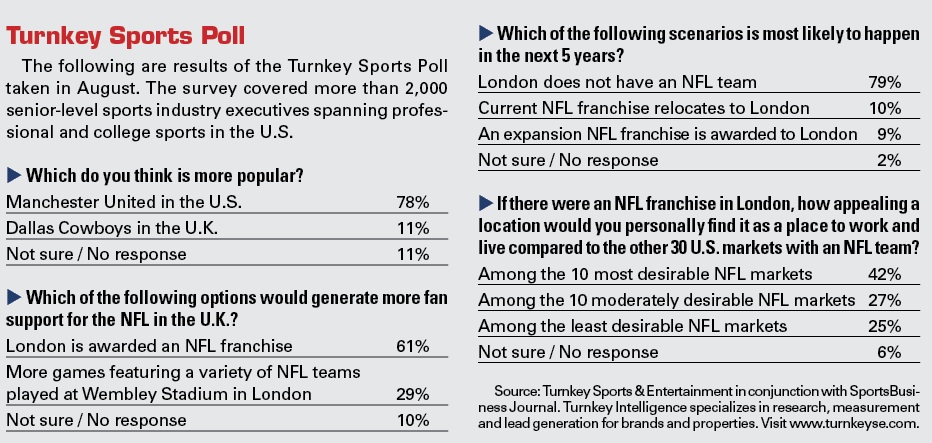It’s hard to convey just how exciting Channel 4 was when it launched on British television screens in 1982. There’s a hint in the name. Until then we had only three television channels, two of which were off air for large parts of the day.
Compared to the dusty, complacent BBC, Channel 4 was a breath of fresh air, and part of its remit was to innovate.
This blue-sky thinking led to the well-meaning but ultimately flawed decision to flag up sexual content in films by placing a red triangle in the corner of the screen. As a teenage boy growing up in suburban London, this was manna from heaven. School break times were spent poring over TV listings organizing our weeks around red triangle nights.
In the down time between dirty movies, Channel 4 showed the NFL.
The medium, as we know, is the message, and on Channel 4, the NFL was niche, two words that are rarely seen in the same sentence. It’s a short jump from niche to cool and in 1982, the NFL felt, bizarre as it sounds now, just a little bit underground.
I remember the first time I saw a kid walking down the street in a Miami Dolphins shirt. Again, memory plays tricks. This was before the explosion of English football club replica shirts became the uniform of the shopping mall. In the early ’80s, wearing a Dolphins shirt was the statement of an insider, closer to an indie band tour T-shirt than Manchester United’s Chevy-branded merchandise.
Then, in the late ’80s, the NFL started to come over to play in London and the excitement died. It was too try-hard, style over substance. The exoticism escaped like bad gas. Oddly, somewhere in the shift from media product to live experience, the life went out of it.
The events we got to see were flabby versions of the game, not the real thing. It was like expecting to get the
 |
In the late 1980s, Gillis said, the NFL missed its mark in London. “It was too try-hard, style over substance.”
Photo by: Getty Images |
authentic perspective of Britain’s capital from the infamous “Friends” London episodes: all Big Ben and Dick Van Dyke accents. Someone made the mistake of telling “The Fridge” that he was a brand and that Britain was a new growth market to be exploited. He and many other stars came over and did the media interview rounds, and slowly we fell out of love with them. It was all too calculating, too cold, too obvious.
Nobody wants to think of themselves as a target market and the NFL made the classic error that bedevils so much of global sports marketing, which is to assume that just because people live far away, they should be talked to like 5-year-olds, or foreigners.
So then it went quiet. For most of the ’90s the NFL existed in the shadows, also known as early British satellite television.
Fast forward to 2014 and football is back on Channel 4. There’s talk of momentum, a building of noise toward a British franchise. It all makes sense on PowerPoint: NFL owners populate the boardrooms of Premier League teams so there’s more than a whiff of synergy in the air.
I’m on the NFL’s marketing radar again, part of the key legacy demographic of fortysomething Londoners who are expected to form the core fan base — and buy the branded duvet covers — of the “London Whatevers,” to borrow NFL Commissioner Roger Goodell’s charming phrase.
But just as important is tone of voice, a point that takes us back to Channel 4 in 1982. Back then I was a Dolphins fan who viewed the NFL as a niche and exotic media product. The distance between me and Florida was central to their appeal. I loved the Dolphins because they weren’t in London.
Today the NFL is anything but niche. There are no secret pleasures in today’s multichannel, globalized sports market. The league has no option other than to come to town with all guns blazing and live up to the promise of its brand DNA. This time around it is big, slick and bold. Wembley fills out for the International Series, some of whom appear to be genuinely engaged fans who sit alongside the big-event junkies who would go to Wembley for the opening of a fridge door (pun intended).
This divide talks to the challenge of London 2.0, which is the difference between selling a one-off event and building a franchise that exists as part of the fabric of the city. It will be fascinating to watch how it unfolds over the next few years.
There is already oversupply in the British sports market. Do I, or my kids, need another team to pull for? Do I have the emotional capacity? And, just as importantly, does the NFL have the physical capacity? Will its inventory — the good stuff — stretch far enough without compromising quality?
The commitment of every team in the NFL is going to be tested because the U.K. fan base will be watching closely for signs that they are being taken seriously this time around. To succeed, the London Whatevers had better be in it for the long term: a genuine franchise playing a full schedule. It’s all or nothing.
Richard Gillis (Richard@gillisonline.co.uk) is the author of the Unofficial Partner sports business blog in London. Follow him on Twitter @richardgillis1.






